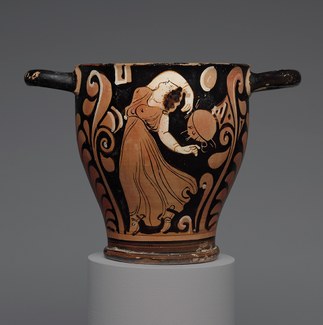What can we know about ancient dance? Why did European avant-garde artists look to antiquity at the beginning of the twentieth century? With an array of ancient representations of dance, Hymn to Apollo: The Ancient World and the Ballet Russes explores both the role of dance in ancient culture and the influence of antiquity on the modernist reinventions of the Ballets Russes, the ground-breaking dance company founded in Paris by Sergei Diaghilev.
With about 100 works, including outstanding examples of ancient pottery, sculpture, and metalwork, as well as watercolors, sketchbooks, photographs, costumes, and other archival material from the Ballets Russes, this exhibition—the first on the topic—reveals a rich, multifaceted dialogue between the ancient and the modern. More than a simple story of the reception of antiquity by artists in the twentieth century, Hymn to Apollo shows how artists returned to antiquity not as benighted traditionalists but as radical revolutionaries, intent on creating something new.
Learn more about this exhibition >>>
Image 1:
Léon Bakst
Costume Design for Tamara Karsavina as Chloé, for Daphnis et Chloé (detail)
ca. 1912
Graphite and tempera and/or watercolor on paper
H. 28.2 cm; W. 44.7 cm
Wadsworth Atheneum Museum of Art, Hartford, CT, The Ella Gallup Sumner and Mary Catlin Sumner Collection Fund: 1933.392
Image: Allen Phillips/Wadsworth Atheneum
Image 2:
Attributed to the Frignano Painter
Skyphos with a Dancing Maenad
Late Classical, 375–350 BCE
Terracotta
Campania, Italy
H. 16.5 cm; W. 15 cm
Harvard Art Museums/Arthur M. Sackler Museum, Gift of Dr. Harris Kennedy, Class of 1894: 1932.56.39
Photo: Imaging Department © President and Fellows of Harvard College

